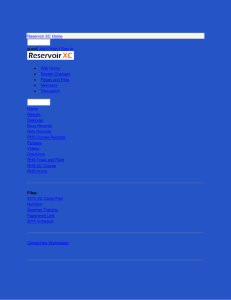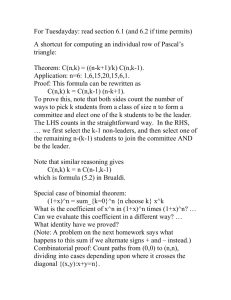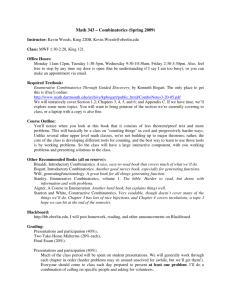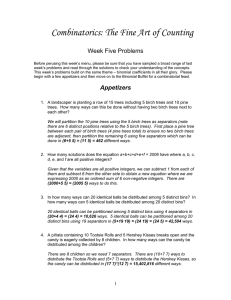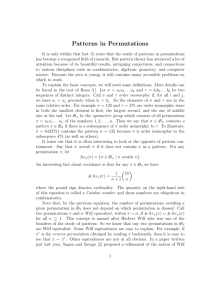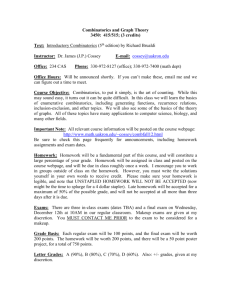I've just shown you three examples. What's Example 4?
advertisement
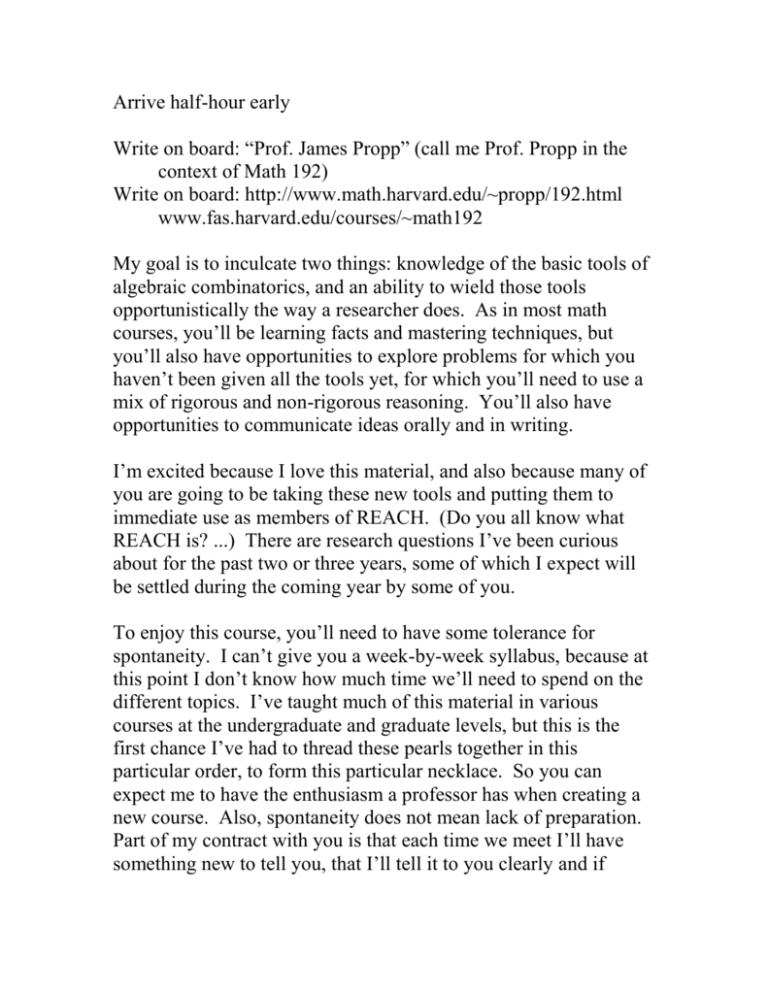
Arrive half-hour early
Write on board: “Prof. James Propp” (call me Prof. Propp in the
context of Math 192)
Write on board: http://www.math.harvard.edu/~propp/192.html
www.fas.harvard.edu/courses/~math192
My goal is to inculcate two things: knowledge of the basic tools of
algebraic combinatorics, and an ability to wield those tools
opportunistically the way a researcher does. As in most math
courses, you’ll be learning facts and mastering techniques, but
you’ll also have opportunities to explore problems for which you
haven’t been given all the tools yet, for which you’ll need to use a
mix of rigorous and non-rigorous reasoning. You’ll also have
opportunities to communicate ideas orally and in writing.
I’m excited because I love this material, and also because many of
you are going to be taking these new tools and putting them to
immediate use as members of REACH. (Do you all know what
REACH is? ...) There are research questions I’ve been curious
about for the past two or three years, some of which I expect will
be settled during the coming year by some of you.
To enjoy this course, you’ll need to have some tolerance for
spontaneity. I can’t give you a week-by-week syllabus, because at
this point I don’t know how much time we’ll need to spend on the
different topics. I’ve taught much of this material in various
courses at the undergraduate and graduate levels, but this is the
first chance I’ve had to thread these pearls together in this
particular order, to form this particular necklace. So you can
expect me to have the enthusiasm a professor has when creating a
new course. Also, spontaneity does not mean lack of preparation.
Part of my contract with you is that each time we meet I’ll have
something new to tell you, that I’ll tell it to you clearly and if
possible entertainingly, and that I’ll let you go by the time the bell
rings.
Before I go into telling you about the mechanics of the course, let
me illustrate something about the nature of algebraic
combinatorics, and give you some of the flavor of the course
Pascal’s Triangle (go up through n=6)
Did Pascal discover it first? ... No, the Chinese did!.
Algebraic interpretation: Coefficient of x^k y^{n-k} in (x+y)^n.
Binomial theorem: For n a non-negative integer,
(x+y)^n = sum_{k=0}^n x^k y^{n-k}
Replace y by 1: (1+x)^n = sum_{k=0}^n x^k
Combinatorial interpretation: Number of combinations of n
objects, taken k at a time. Talk about I Ching hexagrams
(stress: there’s no evidence that the Chinese had this in
mind!)
{n choose k} = {n choose n-k}
1. The sum of the nth row of the triangle is ...; how to prove? ...
induction
algebra (substitution: x=1, y=1) [remember this for later: the
usefulness of substitution!]
combinatorics (counting all subsets)
2. What about the alternating sum of the entries in the nth row?
Observation: sum_{k=0}^n (-1)^k (n choose k) = 0 for n>0.
induction (not hard)
algebra (substitution: ... x=1, y=-1) [what about n=0?]
combinatorics (number of subsets of odd size = number of
subsets of even size); what’s a bijection between odd-sizedsubsets and even-sized subsets? ... Signed enumeration.
Breaking the symmetry by picking a class clown.
3. What about the sum of the squares of the elements in the nth
row? ...
1, 2, 6, 20, 70, 252, ...
Maple: If you type “sum(binomial(5,k)^ 2,k=0..5);” after the
prompt, Maple says “252”.
Or: “f := proc(n) RETURN(sum(binomial(n,k)^2,k=0..n)); end;”
and “f(5);”
Mathematica? ...
Handbook of Integer Sequences (mention link to Sloane from the
REACH home-page)
www.research.att.com/~njas/sequences/
Pattern hunting: ratios!
2/1 = 2, 6/2 = 3, 20/6 = 10/3, 70/20 = 7/2, 252/70 = 18/5, ...
Let’s rewrite 7/2 as 14/4:
2/1, 6/2, 10/3, 14/4, 18/5, ...
Aha!
In fact, these are just the central entries in alternate rows of
Pascal’s triangle
So we conjecture:
sum_{k=0 to n} {n choose k}^2 = {2n choose n}.
Proof by induction? It’s not easy to see where one would even
start.
Proof by algebra:
We want to prove LHS = RHS.
We’ll derive this from the fact that (1+x)^n (1+x)^n = (1+x)^{2n}.
Look at the coefficient of x^n in this polynomial.
On the one hand, it’s equal to
sum_{k=0}^n
(coeff of x^k in (1+x)^n) (coeff of x^{n-k} in (1+x)^n)
= sum_{k=0}^n (n choose k) (n choose n-k)
= sum_{k=0}^n (n choose k) (n choose k)
= sum_{k=0}^n (n choose k)^2
= LHS.
On the other hand, (1+x)^n (1+x)^n = (1+x)^{2n}, in which the
coefficient of x^n is
(2n choose k) = RHS.
You can train yourself to recognize when a trick like this will
work.
The Algebraic Strategy: To prove LHS=RHS, come up with a
polynomial that can be written in two different ways, so that
a certain coefficient can be shown to equal both LHS and
RHS.
Snake Oil (Wilf’s book): pp. 108-120
Proof by computer: Show them the Shalosh proof with sums of
cubes of binomial coefficients.
Wilf and Zeilberger’s approach is sort of a routinized proof by
induction.
To show that A(n) = B(n), show that both satisfy the same
recurrence.
Analogy between algebra and computers (both take away intuition)
Proof by bijection:
We want to prove LHS = RHS.
Look at the set of all ways of choosing a committee of n students
from a class of n boys and n girls.
Let k be the number of boys on the committee. What are the
possible values of k? ... 0 through n.
For each such value of k, how many committees consist of k boys
and n-k girls?... (n choose k) (n choose n-k) = (n choose k)^2.
So the total number of different possible committees is
sum_{k=0}^n (n choose k)^2= LHS.
But the number of different possible committees is also
(2n choose n) = RHS
(just ignore the sex of the students).
I’ve just shown you three examples. What’s Example 4? ...
Hint: Pretend I called them Examples 1(a), 1(b), and 2(a); what’s
example 2(b)? ...
Right! You should always be on the lookout for things like this.
Incomplete analogies are one of the great motors of mathematical
progress.
So, half of your homework assignment for a week from today is to
tabulate values of the alternating sum of squares, formulate a
conjecture, prove it algebraically, and prove it
combinatorially.
Three components of the grade: in-class participation (10%),
homework (50%), take-home exams (50%), with the lowest 10%
being dropped. (No in-class tests.)
Class participation:
Attendance
Tell students I plan to start 5 (not 7 or 10) minutes past the hour
I expect you to have done the assigned reading, or the assigned
skimming. This will make for a more lively class, since you’ll
be less busy scribbling everything down; you’ll be able to get
the big picture and ask questions.
Lots of ways to participate: answering a question (correctly or
not) in a way that propels the discussion forward; asking a good
question; giving a synthesis or a recapitulation. (Or,
occasionally: “I think Joe was trying to say something.”)
The only dumb questions are the ones that don’t get asked. In
asking a question, you show that you know what’s confusing
you. Don’t ridicule other students’ questions.
Feel free to interupt with questions. But you should also respect
my decision if I feel the need to rein in the discussion (say, so
that we can cover everything you’ll need to know in order to do
the homework).
It’s my hope that everyone in the class will get 100% on
participation
Let’s start formally, with hand-raising, and loosen up later in the
semester. If I don’t use your name, please say it!
What it means when I stand aside and avoid eye-contact (look at
the person who’s talking, not me!)
Homework:
6 hours per week of homework, on average (you’ll keep me on
track by telling me how much time you spent on each
assignment)
Some problems will call for discovery and exploration; others
will call for rigorous solution
High marks for judicious use of empirical reasoning.
Computers (Maple vs. Mathematica); some programming will
be involved (nothing major; ten-line programs, typically.) Do
you all have access to computers? ... Do you have access to
training? ... Let’s help each other; let me know how I can help.
“East Side, West Side” gives a good way to jump right into
Maple; is there anything like this for Mathematica?
For some assignments, I’ll want you to write code; you should
email the code to me (so that I or the grader can run your
program without having to type it)
Homework sets and take-homes will be graded not just on the
basis of correctness but also on the basis of clarity.
Collaboration is encouraged, but try the problems on your own
first, and “only take what fits in your brain”. Also, write down
the names of people you worked with (explain how I use this).
Please staple your assignments.
You can submit homework by email, but NOT in Word
Policy on late HW: To be fair to the grader and to the students,
it’s important that the homeworks be graded promptly and all at
the same time. So I’m going to be strict about deadlines. If you
hand in a paper late, and for whatever reason it doesn’t get to
the grader in time, you’ll get a zero for that assignment. (I’ll
only make exceptions for unusual circumstances. If you’ve got
such a circumstance, please tell me ahead of time if you can.)
Lowest 10% of homework grade is dropped. So you get one or
two free excuses from doing an assignment.
Take-home exams:
Two: one due in the middle of the term (let’s pick a date later
this month, to suit your schedules; right now I’m leaning
towards a due-date of November 1), the other due at the end of
Reading Period.
No collaboration with each other, but you can consult with me.
When there’s a take-home, there won’t be homework.
Prerequisites: High school algebra, linear algebra, basic
combinatorics. If you know what a ring is, you’ll recognize lots of
examples in this course; but we won’t use any of the general theory
of rings.
Reading:
“Concrete Mathematics” by Graham, Knuth, and Patashnik, pp.
47-56, 153-172, 196-204, 243-255, 276-280, 283-290, 306-346,
387-396. Do any of you know it? ... What do you think of it? ...
I love it. Is it available at the Coop? ... Amazon? ...
“generatingfunctionology” by Wilf, pp. 1-17, 35-36, 40-41, 9193, 98-99, 108-111.
“East Side, West Side” by Wilf, pp. (Like the previous Wilf
book, it’s on the web for free.) You’ll find links to both books
on the course web-page.
Handouts from other books, which I’ll give you. These books
are: “Enumerative Combinatorics” by Stanley; “Constructive
Combinatorics” by Stanton and White; “Combinatorial Matrix
Theory” by Brualdi and Ryser; ...
I’ll be missing five classes, two of them this month (Rosh
Hashanah and Yom Kippur) and three in November (conferences
in Europe). For each of these dates, it’s my intention either to get a
guest-lecturer or to make a video-lecture and put it up on the Web.
(Do you have other professors who’ve done this? Does it work for
you?)
Note: NO CLASS NEXT TUESDAY.
Instead, I’ll give a lecture on Monday, videotape it, and put it on
the Web: www.fas.harvard.edu/courses/~math192
If you can make it, come to this room at noon on Monday the 17th.
If you have suggestions about the way the course is run, let me
know. Don’t wait until it’s too late for me to change what I’m
doing.
Keep track of your good ideas! If you find clever alternative
solutions to homework problems, or simpler proofs of the theorems
we discuss, make a note of them, so that two years from now,
when you ask me to write a letter of recommendation for grad
school, and I ask “Who are you?”, you’ll be able to say “I’m the
person who ...”
Go around and say who you are, why you’re here and what you
expect to get out of the course, and what movie you liked best this
summer
Office hours: to be arranged (partly based on your schedules).
One of the rules of Shopping Period is that the classes stay still and
the students move around. I’m going to have to break a rule here
and possibly become a moving target, because I need to coordinate
Math 192 with REACH so as to accomodate the maximum number
of students for both, and I inadvertently scheduled them both for
4:00 on Tuesdays and Thursdays.
Hopefully, we can leave Math 192 where it is and move REACH,
but I may need to do it the other way, if that leads to the greatest
good for the greatest number. My apologies to those of you who
may be inconvenienced by this.
How many of you here want to be involved with REACH?
What are your schedules like?
Have students fill out cards about themselves (give them 3-4
minutes):
Name (official name, plus what you like to be called,
CIRCLED)
School, year
Interests (academic and non-)
Major (if declared)
Dorm or approximate address
Phone number
Email address
Scheduling constraints (for REACH, 192, and office hours)
Anything else I should know
Explain why I do this (if you feel uncomfortable about including
this information, let me know)
Phone list will be available over email tomorrow
You are encouraged to form study groups.
“Do not abuse this!”
If someone calls you with a question, try to be helpful.
If you have trouble finding a study partner, see me.
Until I set up regular office hours, feel free to ask me questions by
email, or to try to set up an appointment.
If you’re stuck on a problem, it might be a good idea to check you
email for hints or corrections.
Have the students hand in the cards AND pick up the handouts
Hand out assignment #1 (due in class, or by email before class,
next Thursday)
Reading for Thursday:
Intro to generating functions: Wilf, pp. 1-10


